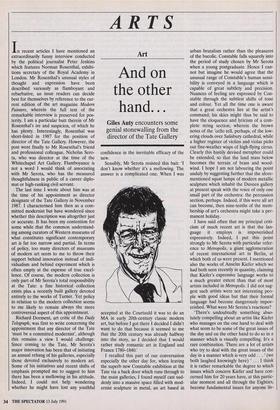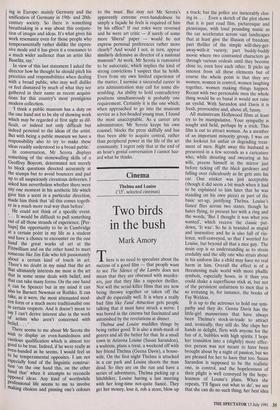ARTS
Art
And on the other hand...
Giles Auty encounters some genial stonewalling from the director of the Tate Gallery
I n recent articles I have mentioned an extraordinarily funny interview conducted by the political journalist Peter Jenkins which features Norman Rosenthal, exhibi- tions secretary of the Royal Academy in London. Mr Rosenthal's unusual styles of thought and expression have been described variously as flamboyant and rebarbative, an issue readers can decide best for themselves by reference to the cur- rent edition of the art magazine Modem Painters, wherein the full text of the remarkable interview is preserved for pos- terity. I am a particular butt therein of Mr Rosenthal's ire and suspicion, of which he has plenty. Interestingly, Rosenthal was short-listed in 1987 for the position of director of the Tate Gallery. However, the post went finally to Mr Rosenthal's friend and professional colleague, Nicholas Sero- ta, who was director at the time of the Whitechapel Art Gallery. Flamboyance is not a word I would think of associating with Mr Serota, who has the measured thoughtfulness in public of a career diplo- mat or high-ranking civil servant.
The last time I wrote about him was at the time of his appointment as director designate of the Tate Gallery in November 1987. I characterised him then as a com- mitted modernist but have wondered since whether this description was altogether just or accurate. It has been my contention for some while that the common understand- ing among curators of Western museums of what constitutes significant contemporary art is far too narrow and partial. In terms of policy, too many directors of museums of modern art seem to me to throw their support behind innovation instead of indi- vidualism and behind experiment which is often empty at the expense of true excel- , lence. Of course, the modern collection is only part of Mr Serota's total responsibility at the Tate: a fine historical collection exists plus a recently built gallery devoted entirely to the works of Turner. Yet policy in relation to the modern collection seems to me likely to remain always the more controversial aspect of this appointment.
Richard Dorment, art critic of the Daily Telegraph, was first to write concerning the appointment that any director of the Tate `must be a committed modernist', although this remains a view I would challenge. Since coming to the Tate, Mr Serota's major innovation has been that of initiating an annual rehang of his galleries, especially those devoted exclusively to modern art. Some of his initiatives and recent shifts of emphasis prompted me to suggest to him there has been a mellowing in his attitude. Indeed, I could not help wondering whether he might have lost any youthful confidence in the inevitable efficacy of the new.
Sensibly, Mr Serota resisted this bait: 'I don't know whether it's a mellowing. The answer is a complicated one. When I was accepted at the Courtauld it was to do an MA in early 20th-century classic modern art, but before I got there I decided I didn't want to do that because it seemed to me that the 20th century was already halfway into the story, so I decided that I would rather study romantic art in England and France 1780-1840.'
I recalled this part of our conversation especially the other day for, when leaving the superb new Constable exhibition at the Tate via a back door which runs through to the main galleries, I found myself cast sud- denly into a massive space filled with mod- ernist sculpture in metal, an art based in urban brutalism rather than the pleasures of the bucolic. Constable falls squarely into the period of study chosen by Mr Serota when a young postgraduate. Hence I can- not but imagine he would agree that the unusual range of Constable's human sensi- bility is conveyed in a language which is capable of great subtlety and precision. Nuances of feeling are expressed by Con- stable through the subtlest shifts of tone and colour. Yet all the time one is aware that a great orchestra lies at the artist's command; his skies might thus be said to have the eloquence and lyricism of a com- plete string section, wherein the brown notes of the 'cello tell, perhaps, of the low- ering clouds over Salisbury cathedral, while a higher register of violins and violas picks out fine-weather wisps of high-flying cirrus. Clearly this hastily devised metaphor could be extended, so that the land mass below becomes the terrain of brass and wood- wind. I hope I am not labouring the point unduly by suggesting further that the afore- mentioned squat lumps of modern metallic sculpture which inhabit the Duveen gallery at present speak with the voice of only one small part of the orchestra: the percussion section, perhaps. Indeed, if this were all art can become, then nine-tenths of the mem- bership of art's orchestra might take a per- manent holiday.
I have said often that my principal criti- cism of much recent art is that the lan- guage it employs is impoverished expressively. Indeed, I put this point strongly to Mr Serota with particular refer- ence to Metropolis, a giant agglomeration of recent international art in Berlin, at which both of us were present. I mentioned also the works of Anselm Kiefer which we had both seen recently in quantity, claiming that Kiefer's expressive language works to a much greater extent than that of most artists included in Metropolis. I did not sug- gest such artists were not interesting peo- ple with good ideas but that their formal language had become dangerously impov- erished. What were Mr Serota's reactions?
`There's undoubtedly something abso- lutely compelling about an artist like Kiefer who manages on the one hand to deal with what seem to be some of the great issues of the day and on the other hand to do so in a manner which is visually compelling. It's a rare combination. There are a lot of artists who try to deal with the great issues of the day in a manner which is very odd . ' (we both laughed knowingly here) . . . I think it is rather remarkable the degree to which issues which concern Kiefer and have con- cerned him for 20 years have, at this partic- ular moment and all through the Eighties, become fundamental issues for anyone liv- ing in Europe: mainly Germany and the unification of Germany in 19th- and 20th- century society. So there is something breathtaking in a way about this conjunc- tion of images and ideas. It's what gives his work resonance even for those people who temperamentally rather dislike the expres- sive mode and it has given it a resonance to a much wider audience than an artist like Baselitz, say.'
In view of this last statement I asked the director how he thought he should pitch his priorities and responsibilities when dealing with a broad public, who may well dislike or feel dismayed by much of what they see gathered in their name as recent acquisi- tions for this country's most prestigious modern collection.
`I think a public museum has a duty on the one hand not to be shy of showing work which may be regarded at first sight as dif- ficult, or indeed not only difficult but indeed personal to the ideas of the artist. But with being a public museum we have a responsibility also to try to make these ideas readily understood to a broad public.'
In conversation, Mr Serota displays something of the stonewalling skills of a Geoffrey Boycott, determined not merely to block questions directed accurately at the stumps but to avoid bouncers and pad up to all suspiciously circuitous deliveries. I asked him nevertheless whether there were any one moment in his aesthetic life which gave him a scent in a particular direction, made him think that 'all this comes togeth- er in a much more real way than before'.
He could not think of a specific event.
. . It would be difficult to pull something out of all those strands of experience. [Per- haps] the opportunity to be in Cambridge at a certain point in my life as a student and have a chance to encounter on the one hand the great works of art at the Fazwilliam and on the other hand to meet someone like Jim Ede who felt passionately about a certain kind of touch in art. There's no doubt in my mind that the art that ultimately interests me most is the art that in some sense deals with belief, and that can take many forms. On the one hand a can be Spencer but in my mind it can also be Barnett Newman or Rothko. It can take, as it were, the most attenuated mod- Fro form or a much more traditionalist one m certain respects. And it doesn't mean to say I can't derive interest also in the work of artists who aren't concerned with belief. . • • There seems to me about Mr Serota the wish to display an even-handedness and cautious qualification which is almost too good to be true. Indeed, if he were really as even-handed as he seems, I would feel us to be temperamental opposites. I am not especially fond of the linguistic construc- tion 'on the one hand this, on the other hand that' when it attempts to reconcile °Pposed ideas. Any kind of worthwhile professional life seems to me to involve making choices and pinning one's colours to the mast. But may not Mr Serota's apparently extreme even-handedness be simply a façade he feels is required of him by his office? If our roles were reversed and he were art critic — if surely of some more 'liberal' paper — would he not express personal preferences rather more clearly? And would I not, in turn, appear similarly defensive as director of a national museum? At work, Mr Serota is rumoured to be autocratic, which implies the kind of strong convictions I suspect that he holds. Even from my own limited experience of the matter, I surmise a successful career in arts administration may call for some dis- sembling. An ability to hold contradictory positions simultaneously is probably one requirement. Certainly it is the one which, when approached to go into the museum service as a hot-headed young man, I found the most unacceptable. As a career arts administrator, Mr Serota keeps his own counsel, blocks the press skilfully and has thus been able to acquire central, rather than peripheral power in the life of the art community. I regret only that at the end of an hour's genial conversation I cannot haz- ard what he thinks.



















































 Previous page
Previous page